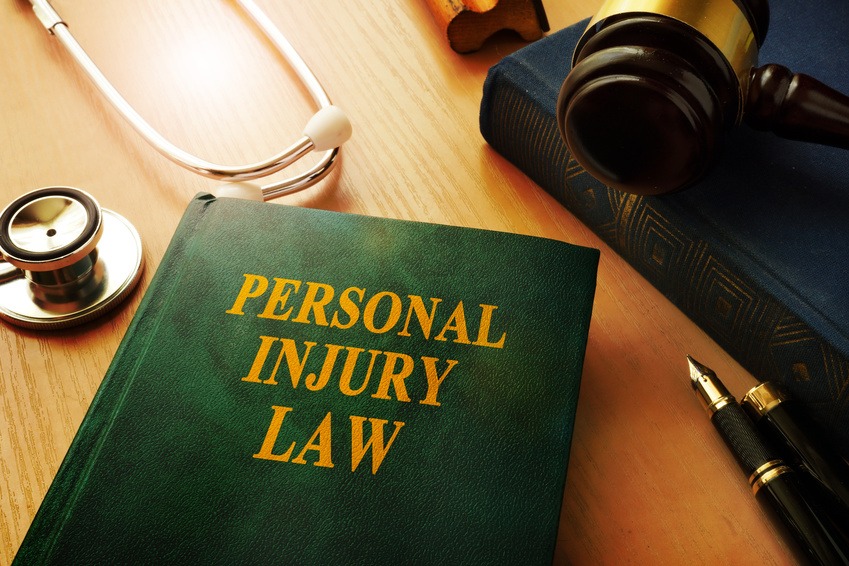Navigating Personal Injury Claims: A Comprehensive Guide by Your Trusted Personal Injury Attorney

The Hidden Toll of Personal Injuries
Imagine this: Every year, over 39 million people in the United States seek medical attention for accidental injuries. This staggering statistic highlights not only the frequency of personal injuries but also their significant impact on individuals and families. From car accidents and workplace mishaps to slip and fall incidents, personal injuries can disrupt lives, resulting in physical pain, emotional distress, and financial burdens. For more information, visit the CDC Injury Statistics.
Unveiling the Role of Your Personal Injury Attorney

In the wake of an injury, navigating the legal landscape can be overwhelming. This is where a personal injury attorney steps in, offering expertise and guidance. In this article, you’ll discover the critical role these legal professionals play in personal injury cases. We’ll explore how they assess claims, gather evidence, negotiate with insurance companies, and, if necessary, represent you in court. By the end of this guide, you’ll understand the importance of having a skilled attorney on your side and the steps involved in the personal injury claims process. For more insights, see the American Bar Association’s guide to personal injury law.
Empowering You with Knowledge and Support
The purpose of this article is to arm you with the knowledge needed to confidently handle a personal injury claim. Whether you’re dealing with the aftermath of a car accident, a slip and fall, or any other type of injury, understanding the process and the support available to you is crucial. We’ll delve into the intricacies of personal injury law, common challenges faced by claimants, and tips for choosing the right attorney. By shedding light on these aspects, we aim to alleviate some of the stress associated with personal injuries and ensure you are well-prepared to seek the compensation you deserve.
Understanding Personal Injury Law
Defining Personal Injury: What Does It Entail?
Personal injury law encompasses any harm caused to an individual’s body, mind, or emotions due to another party’s negligence or intentional actions. It is a broad area of law designed to protect individuals who have suffered physical or psychological damage as a result of accidents, mistakes, or malicious intent. The goal is to ensure that victims receive compensation for their injuries, losses, and suffering. For an in-depth explanation, visit the Legal Information Institute’s personal injury law page.
Diverse Scenarios: Types of Personal Injury Cases
Personal injury cases can arise from various circumstances. Here are some of the most common types:
- Motor Vehicle Accidents: These are the most frequent type of personal injury claims. They include accidents involving cars, motorcycles, trucks, bicycles, and pedestrians. The injuries can range from minor cuts and bruises to severe, life-altering conditions. Learn more from the National Highway Traffic Safety Administration.
- Slip and Fall Incidents: These cases involve injuries that occur when someone slips, trips, or falls on another person’s property due to hazardous conditions like wet floors, uneven surfaces, or poor lighting. Property owners are typically responsible for ensuring their premises are safe. For more information, see the Nolo Guide on Slip and Fall Accidents.
- Workplace Injuries: These injuries happen on the job and can include anything from repetitive strain injuries to accidents caused by machinery. Workers’ compensation laws often govern these claims, but there can also be third-party liability in some cases. For details on workplace injuries, refer to the Occupational Safety and Health Administration.
- Medical Malpractice: This type of personal injury occurs when a healthcare provider fails to provide the standard of care expected, leading to patient harm. Examples include surgical errors, misdiagnoses, and medication mistakes. More information can be found at the Nolo Guide on Medical Malpractice.
- Product Liability: These cases involve injuries caused by defective or dangerous products. Manufacturers, distributors, or retailers can be held accountable if a product is found to be inherently unsafe or if it lacks proper warnings and instructions. Learn more from the Consumer Reports on Product Recalls.
The Legal Framework: Principles Guiding Personal Injury Law
The legal principles governing personal injury law are designed to ensure justice and fair compensation for victims. Key aspects include:
- Negligence: The cornerstone of most personal injury claims, negligence occurs when a person or entity fails to exercise reasonable care, resulting in harm to another. To prove negligence, the claimant must show that the defendant owed a duty of care, breached that duty, and caused the injury. For more details, visit Cornell Law School’s Legal Information Institute.
- Strict Liability: In certain cases, especially product liability, strict liability applies. This means a defendant can be held liable for damages without the need to prove negligence or intent. The mere fact that a product was defective and caused injury can be sufficient. For more information, see the Legal Information Institute’s page on strict liability.
- Damages: Compensation in personal injury cases can be categorized into economic and non-economic damages. Economic damages cover tangible losses like medical bills, lost wages, and property damage. Non-economic damages address intangible aspects such as pain and suffering, emotional distress, and loss of enjoyment of life. For more information, visit the Legal Information Institute’s page on damages.
- Statutes of Limitations: Personal injury claims must be filed within a specific timeframe, known as the statute of limitations. This period varies depending on the type of injury and jurisdiction. Failing to file within this period can result in the loss of the right to seek compensation. For more details, visit the FindLaw Guide on Statutes of Limitations.
The Role of a Personal Injury Attorney
Initial Consultation: Setting the Foundation
When you first meet with a personal injury attorney, this initial consultation is crucial for both parties. Here’s what you can expect:
- Discussion of Your Case: The attorney will ask detailed questions about the incident that led to your injury. Be prepared to provide a comprehensive account, including dates, locations, witnesses, and any other relevant details.
- Review of Evidence: Bring any documents related to your case, such as medical records, police reports, photos of injuries or accident scenes, and correspondence with insurance companies. This helps the attorney evaluate the strength of your case.
- Explanation of the Process: The attorney will explain the legal process, potential outcomes, and what to expect in terms of timelines and fees. They will also discuss their contingency fee arrangement, meaning you only pay if you win your case.
Providing detailed information during this consultation is essential. The more accurate and thorough you are, the better your attorney can assess and strategize your case.
Case Evaluation: Assessing Validity and Value
Once the initial consultation is over, the attorney will evaluate your case to determine its validity and potential value. This involves:
- Investigating the Incident: The attorney will conduct a thorough investigation, which may include visiting the accident scene, interviewing witnesses, and consulting experts.
- Gathering Evidence: Collecting all necessary documentation is critical. This includes medical records, bills, employment records (for lost wages), and any other evidence that supports your claim.
- Valuing the Claim: Attorneys assess the financial impact of your injuries, considering medical expenses, lost income, pain and suffering, and other damages. They use this information to estimate a fair settlement amount.
Legal Representation: Advocating for Your Rights
Once your case is evaluated, your attorney will take on the role of your legal representative, handling various aspects of your claim:
- Negotiating with Insurance Companies: Insurance companies often aim to minimize payouts. Your attorney will negotiate on your behalf to ensure you receive a fair settlement. They understand the tactics insurers use and can effectively counter them. For more on dealing with insurance companies, see Nolo’s Guide on Dealing with Insurance Adjusters.
- Preparing for Court: If a fair settlement cannot be reached, your attorney will prepare your case for court. This involves gathering further evidence, preparing witnesses, and crafting a compelling argument.
- Court Representation: During the trial, your attorney will represent you, presenting evidence and arguments to the judge or jury. They aim to prove the defendant’s liability and demonstrate the extent of your damages.
- Ensuring Fair Compensation: The ultimate goal of your attorney is to secure fair compensation for your injuries and losses. They will fight to ensure you receive the maximum amount you are entitled to, covering both economic and non-economic damages.
The Personal Injury Claims Process
Filing a Claim: Taking the First Step
Initiating a personal injury claim involves several critical steps. Here’s a roadmap to get you started:
- Consult with a Personal Injury Lawyer: The first step is to meet with a personal injury lawyer to discuss your case and determine if you have a valid claim.
- File the Claim: Your lawyer will help you file the necessary paperwork with the appropriate court or agency. This typically includes a complaint detailing the nature of your injuries and how they occurred.
- Adhere to Deadlines: It’s crucial to file your claim within the statute of limitations, which varies by state and type of injury. Missing this deadline can result in losing your right to compensation. For more details, visit the FindLaw Guide on Statutes of Limitations.
Understanding these steps can prevent delays and ensure your claim is filed correctly.
Investigation: Building Your Case

After filing, the next phase is the investigation, where personal injury lawyers gather and preserve crucial evidence to support your claim:
- Collecting Evidence: Your lawyer will gather medical records, accident reports, photographs, and any other relevant documentation.
- Interviewing Witnesses: They will speak to witnesses who can provide firsthand accounts of the incident, helping to establish fault and damages.
- Consulting Experts: Expert witnesses, such as medical professionals or accident reconstruction specialists, may be consulted to strengthen your case. For more on the importance of evidence, refer to the Legal Information Institute.
This thorough investigation is essential for building a robust case.
Negotiation and Settlement: Finding Common Ground
Before going to trial, many personal injury claims are resolved through negotiation and settlement:
- Negotiation Strategies: Your lawyer will negotiate with the insurance company or the defendant’s legal team to reach a fair settlement. They will present evidence, demonstrate liability, and argue for maximum compensation.
- Evaluating Offers: Deciding whether to accept a settlement or proceed to trial depends on the offer’s adequacy in covering your damages. Personal injury attorneys will provide guidance on whether the settlement reflects the true value of your claim. For more on negotiation tactics, visit Nolo’s Guide on Settling Personal Injury Claims.
Understanding when to settle and when to push for trial is crucial.
Litigation: Pursuing Justice in Court
If a settlement cannot be reached, the case moves to litigation:
- Preparing for Court: Your lawyer will prepare by organizing evidence, filing pre-trial motions, and preparing witnesses for testimony.
- The Trial Process: During the trial, both sides present their arguments, evidence, and witness testimonies. Your lawyer will work to prove the defendant’s liability and the extent of your damages.
- Post-Trial Procedures: If the trial results in a favorable verdict, the court will award damages. However, the defendant may appeal the decision, potentially prolonging the resolution. For more insights, explore resources on the American Bar Association website.
Navigating the complexities of a trial requires experienced personal injury attorneys.
Common Challenges in Personal Injury Cases
Dealing with Insurance Companies: Navigating the Minefield
Insurance companies are notorious for employing tactics to minimize payouts, making it challenging for claimants to receive fair compensation. Here are some common strategies insurers use and how personal injury attorneys counteract them:
- Lowball Offers: Insurers often start with low settlement offers, hoping claimants will accept quickly. A personal injury lawyer ensures you don’t settle for less than you deserve by accurately assessing the value of your claim.
- Delay Tactics: By delaying the processing of claims, insurers can pressure claimants into accepting lower settlements out of financial desperation. Attorneys expedite the process by persistently following up and, if necessary, filing a lawsuit to force timely action.
- Disputing Liability: Insurers may argue that their policyholder was not at fault. Personal injury attorneys gather substantial evidence, such as accident reports, witness statements, and expert testimony, to build a strong case proving liability. For more on dealing with insurance companies, check out Nolo’s Guide.
Proving Liability: The Cornerstone of Your Case
Establishing fault in a personal injury case is often complex and requires thorough investigation. Here are some challenges and the role of evidence and expert testimony:
- Complex Accidents: In cases involving multiple parties, determining fault can be particularly challenging. Attorneys use accident reconstruction experts to clarify how the incident occurred and who is responsible.
- Lack of Clear Evidence: Sometimes, the evidence is not straightforward. Personal injury lawyers collect and preserve all possible evidence, from surveillance footage to digital records, ensuring nothing is overlooked.
- Expert Testimony: Expert witnesses, such as medical professionals and accident reconstruction specialists, can provide critical testimony that supports your claim by explaining technical details to the court. To understand more about proving liability, visit FindLaw.
Calculating Damages: Understanding Your Compensation
Determining the compensation amount in personal injury cases involves assessing both economic and non-economic damages. Here are the types of damages and factors influencing compensation:
- Economic Damages: These include tangible losses such as medical expenses, rehabilitation costs, lost wages, and property damage. Personal injury lawyers gather all financial documentation to ensure every expense is accounted for.
- Non-Economic Damages: These are intangible losses, such as pain and suffering, emotional distress, and loss of enjoyment of life. Attorneys use various methods to quantify these damages, ensuring fair compensation.
- Factors Influencing Compensation: The severity of the injury, the impact on the claimant’s quality of life, and future medical needs are all considered when calculating damages. Personal injury attorneys work with medical experts and financial analysts to project long-term costs and losses. For more on calculating damages, visit the Nolo Guide on Damages.
Tips for Choosing the Right Personal Injury Attorney
Qualifications and Experience: Finding the Best Fit
Choosing the right personal injury attorney is crucial for the success of your case. Here’s what to look for:
- Specialized Knowledge: Ensure the attorney specializes in personal injury law. A lawyer with specific expertise in personal injury will be more familiar with relevant laws and procedures.
- Track Record: Look for an attorney with a proven track record of successful case outcomes. This can include settlements and verdicts in cases similar to yours.
- Experience in Specific Cases: It’s essential that the attorney has experience handling cases similar to yours, whether it’s motor vehicle accidents, medical malpractice, or product liability. This specialized experience can significantly impact the outcome of your case. For more insights on qualifications and experience, visit Nolo.

Reputation and Reviews: Trustworthy and Reliable
Evaluating the reputation and reviews of potential attorneys can provide valuable insights:
- Client Reviews: Look for reviews and testimonials from previous clients. These can be found on the attorney’s website, Google reviews, or legal directories like Avvo.
- Professional Ratings: Check professional ratings on sites like Martindale-Hubbell, which provide peer reviews of lawyers’ skills and ethics.
- Referrals: Ask for referrals from friends, family, or other lawyers. Personal recommendations can help you find reputable attorneys. Researching an attorney’s reputation can be pivotal in making an informed decision. For more guidance, check FindLaw.
Fee Structures: Understanding Costs
Personal injury attorneys typically work on a contingency fee basis, but it’s important to understand all potential costs:
- Contingency Fees: This means the attorney only gets paid if you win your case. The fee is usually a percentage of the settlement or award, often ranging from 25% to 40%. For more on contingency fees, visit AllLaw.
- Additional Costs: Be aware of other potential expenses that might arise, such as court fees, costs for obtaining medical records, or fees for expert witnesses. Some attorneys cover these costs upfront and deduct them from your settlement, while others may require you to pay them as they arise. For details on additional costs, see the AllLaw Guide on Legal Costs.
- Fee Agreements: Always read and understand the fee agreement before signing. Ensure it clearly outlines the attorney’s fees and any additional costs you might be responsible for. Understanding the fee structure is crucial to avoid any financial surprises. For more information on fee structures, refer to the American Bar Association.
Maximizing Your Claim After a Car Accident
Steps to Take Immediately After an Accident
Taking the right steps immediately after a car accident can significantly impact the outcome of your claim. Here’s what you should do:
- Seek Medical Attention: Your health is the top priority. Even if you feel fine, some injuries may not be immediately apparent. Get a thorough medical examination to document any injuries related to the auto accident. Learn more from the WebMD Guide on Car Crash Injuries.
- Document the Scene: If you are able, take photos of the accident scene, including vehicle damage, road conditions, and any visible injuries. This visual evidence can be crucial in supporting your claim. For more tips, visit the State Farm Guide.
- Exchange Information: Collect contact and insurance information from the other driver(s) involved in the accident. Be sure to get names, addresses, phone numbers, and vehicle details.
- Contact Law Enforcement: File a police report to have an official record of the accident. This report can be a valuable piece of evidence when dealing with the insurance company.
- Gather Witness Information: If there are any witnesses, obtain their contact information and ask for their accounts of the accident. Witness statements can support your version of events.
- Notify Your Insurance Company: Report the accident to your insurance company as soon as possible. Provide them with the necessary details, but be cautious about giving any statements that could be used against you later. More details can be found at the NerdWallet Guide on Filing Auto Insurance Claims.
- Contact a Car Accident Lawyer: Consult with a car accident lawyer promptly. An experienced attorney can guide you through the process, protect your rights, and help maximize your compensation. For more information, visit the Nolo Guide on What to Do After a Car Accident.
Importance of Preserving Evidence and Maintaining Records
Preserving evidence and maintaining accurate records are crucial for building a strong case. Here’s why:
- Evidence Supports Your Claim: Photographs, medical records, police reports, and witness statements all serve as evidence to support your claim and prove the extent of your damages. Learn more from the Nolo Guide on Evidence.
- Consistency and Accuracy: Keeping detailed records of your injuries, treatments, and any expenses related to the accident ensures that your claim is accurate and comprehensive. This includes medical bills, repair costs, and lost wages.
- Timeline of Events: Maintaining a timeline of events, from the accident to your recovery process, helps establish a clear narrative of how the accident has impacted your life.
- Communication Logs: Keep a log of all communications with the insurance company and any other parties involved. This can help track the progress of your claim and identify any discrepancies or delays.
How an Attorney Can Help Maximize Your Compensation
Hiring a car accident lawyer can greatly enhance your ability to secure maximum compensation. Here’s how:
- Expertise in Personal Injury Law: A seasoned attorney understands the intricacies of personal injury law and knows how to navigate the legal system effectively. They can identify all potential sources of compensation and ensure no aspect of your claim is overlooked. More information can be found at the LegalZoom Guide.
- Negotiation Skills: Dealing with insurance companies can be challenging. Attorneys are skilled negotiators who can counter lowball offers and push for a fair settlement that truly reflects the extent of your damages.
- Evidence Gathering: A law firm will conduct a thorough investigation, gathering all necessary evidence to build a compelling case. This includes working with experts, such as accident reconstruction specialists and medical professionals, to substantiate your claims.
- Legal Strategy: Your attorney will develop a legal strategy tailored to your case, whether it involves negotiating a settlement or preparing for trial. They will ensure all legal documents are filed correctly and deadlines are met.
- Advocacy in Court: If your case goes to trial, having a lawyer to represent you can make a significant difference. They will present your case persuasively, cross-examine witnesses, and advocate for your rights before the judge and jury.
- Maximizing Non-Economic Damages: In addition to economic damages like medical bills and lost wages, an attorney can help you pursue non-economic damages for pain and suffering, emotional distress, and loss of enjoyment of life.
For further guidance, explore more resources and expert advice on navigating personal injury claims.
